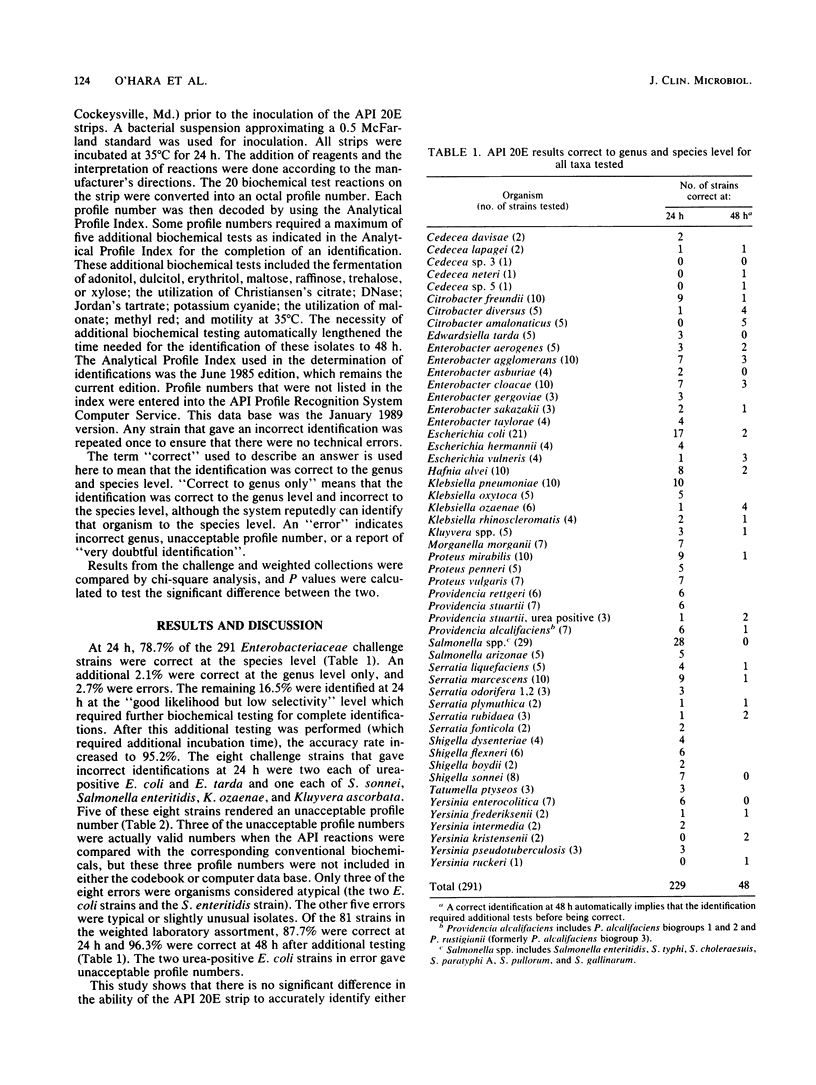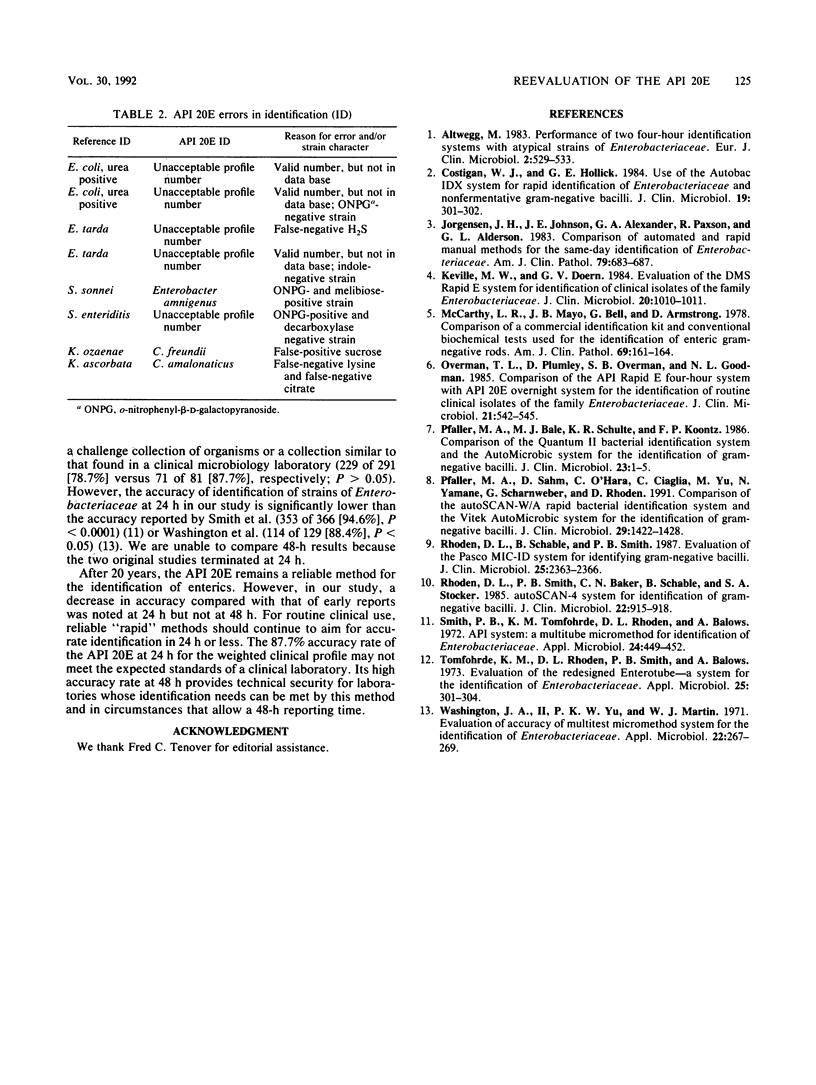Abstract
The API 20E bacterial identification system has been used for 19 years, often as the standard with which other identification systems are compared. Because the accuracy of this system compared with conventional biochemical tests has not been determined in many years, we evaluated the API 20E linear strip by using 291 typical and atypical strains of the family Enterobacteriaceae taken from a culture collection. At 24 h, the API 20E correctly identified by genus and species 229 of 291 (78.7%) of the strains, using Salmonella and Shigella serotyping where indicated. At 48 h, 95.2% were correctly identified by using additional biochemical tests as recommended by the manufacturer. The API 20E misidentified eight (2.7%) strains; these strains were not limited to any particular genus. When 81 of these Enterobacteriaceae strains were arranged into a weighted assortment correlating to the frequency with which they might be found in a clinical laboratory, the API 20E correctly identified 71 (87.7%) at 24 h and 78 (96.3%) at 48 h. This evaluation concluded that the accuracy of the identification of Enterobacteriaceae strains at 24 h (78.7%) may be significantly lower than that of earlier evaluations. However, there is no significant difference in the ability of the API 20E to correctly identify "challenge" type organisms (229 of 291) versus routine hospital isolates (71 of 81) (P greater than 0.05), but the system is not as accurate as the conventional biochemical method of identification.
Full text
PDF


Selected References
These references are in PubMed. This may not be the complete list of references from this article.
- Altwegg M. Performance of two four-hour identification systems with atypical strains of Enterobacteriaceae. Eur J Clin Microbiol. 1983 Dec;2(6):529–533. doi: 10.1007/BF02016560. [DOI] [PubMed] [Google Scholar]
- Costigan W. J., Hollick G. E. Use of the Autobac IDX system for rapid identification of Enterobacteriaceae and nonfermentative gram-negative bacilli. J Clin Microbiol. 1984 Feb;19(2):301–302. doi: 10.1128/jcm.19.2.301-302.1984. [DOI] [PMC free article] [PubMed] [Google Scholar]
- Jorgensen J. H., Johnson J. E., Alexander G. A., Paxson R., Alderson G. L. Comparison of automated and rapid manual methods for the same-day identification of Enterobacteriaceae. Am J Clin Pathol. 1983 Jun;79(6):683–687. doi: 10.1093/ajcp/79.6.683. [DOI] [PubMed] [Google Scholar]
- Keville M. W., Doern G. V. Evaluation of the DMS Rapid E system for identification of clinical isolates of the family Enterobacteriaceae. J Clin Microbiol. 1984 Nov;20(5):1010–1011. doi: 10.1128/jcm.20.5.1010-1011.1984. [DOI] [PMC free article] [PubMed] [Google Scholar]
- McCarthy L. R., Mayo J. B., Bell G., Armstrong D. Comparison of a commercial identification kit and conventional biochemical tests used for the identification of enteric gram-negative rods. Am J Clin Pathol. 1978 Feb;69(2):161–164. doi: 10.1093/ajcp/69.2.161. [DOI] [PubMed] [Google Scholar]
- Overman T. L., Plumley D., Overman S. B., Goodman N. L. Comparison of the API rapid E four-hour system with the API 20E overnight system for the identification of routine clinical isolates of the family Enterobacteriaceae. J Clin Microbiol. 1985 Apr;21(4):542–545. doi: 10.1128/jcm.21.4.542-545.1985. [DOI] [PMC free article] [PubMed] [Google Scholar]
- Pfaller M. A., Bale M. J., Schulte K. R., Koontz F. P. Comparison of the Quantum II Bacterial Identification System and the AutoMicrobic System for the identification of gram-negative bacilli. J Clin Microbiol. 1986 Jan;23(1):1–5. doi: 10.1128/jcm.23.1.1-5.1986. [DOI] [PMC free article] [PubMed] [Google Scholar]
- Pfaller M. A., Sahm D., O'Hara C., Ciaglia C., Yu M., Yamane N., Scharnweber G., Rhoden D. Comparison of the autoSCAN-W/A rapid bacterial identification system and the Vitek AutoMicrobic system for identification of gram-negative bacilli. J Clin Microbiol. 1991 Jul;29(7):1422–1428. doi: 10.1128/jcm.29.7.1422-1428.1991. [DOI] [PMC free article] [PubMed] [Google Scholar]
- Rhoden D. L., Schable B., Smith P. B. Evaluation of PASCO MIC-ID system for identifying gram-negative bacilli. J Clin Microbiol. 1987 Dec;25(12):2363–2366. doi: 10.1128/jcm.25.12.2363-2366.1987. [DOI] [PMC free article] [PubMed] [Google Scholar]
- Rhoden D. L., Smith P. B., Baker C. N., Schable B. autoSCAN-4 system for identification of gram-negative bacilli. J Clin Microbiol. 1985 Dec;22(6):915–918. doi: 10.1128/jcm.22.6.915-918.1985. [DOI] [PMC free article] [PubMed] [Google Scholar]
- Smith P. B., Tomfohrde K. M., Rhoden D. L., Balows A. API system: a multitube micromethod for identification of Enterobacteriaceae. Appl Microbiol. 1972 Sep;24(3):449–452. doi: 10.1128/am.24.3.449-452.1972. [DOI] [PMC free article] [PubMed] [Google Scholar]
- Tomfohrde K. M., Rhoden D. L., Smith P. B., Balows A. Evaluation of the redesigned enterotube--a system for the identification of Enterobacteriaceae. Appl Microbiol. 1973 Feb;25(2):301–304. doi: 10.1128/am.25.2.301-304.1973. [DOI] [PMC free article] [PubMed] [Google Scholar]
- Washington J. A., 2nd, Yu P. K., Martin W. J. Evaluation of accuracy of multitest micromethod system for identification of Enterobacteriaceae. Appl Microbiol. 1971 Sep;22(3):267–269. doi: 10.1128/am.22.3.267-269.1971. [DOI] [PMC free article] [PubMed] [Google Scholar]


